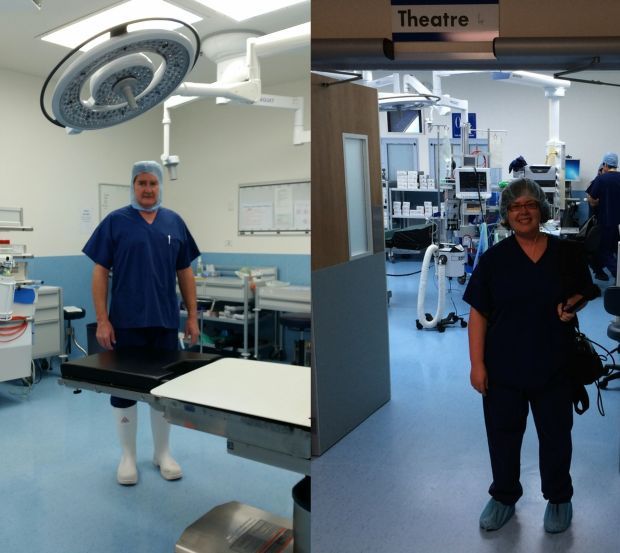It’s just a more expensive version of lino, but thousands of New Zealanders have polyethylene in their hip sockets.
“Polyethylene has existed since 1961 and it’s looked exactly the same until 2014. There is absolutely no difference in the look, the shape, the material, the colour, or the consistency,” says orthopaedic surgeon Peter Devane.

Peter Devane in the operating theatre and Ruth Beran after recording Fiona James' hip revision operation
However, a new form of highly cross-linked polyethylene was developed over a decade ago, and Peter and fellow surgeon Geoffrey Horne from the Surgical Research Trust conducted hip replacement surgery on 122 patients to determine whether it was a better material than conventional polyethylene.
“In the lab, the mechanical properties of the cross-linked polyethylene is slightly different and that was one of the concerns when we first started using it,” says Peter. “It may have been more brittle, it may have worn slower but it may have been more likely to fracture or come loose out of the metal shell.”
Fiona James was one of the patients involved in the trial, and neither she nor the surgeons knew which type of polyethylene she had received, because it was double-blinded. However, as part of the follow-up to her operation, she had X-rays taken at regular intervals, and although she was not in much pain, recently discovered that she would need hip revision surgery to replace the worn parts from the “ball and socket” of her hip.
“When you look at the X-Ray, you see a metal socket implanted into the pelvis. And you would expect to see the metal ball absolutely lined up centrally within the metal socket. In Fiona’s case it shows that the metal ball has migrated quite significantly, into the socket. Indicating quite a lot of wear,” says Peter.
On the day of the revision surgery at Wakefield Hospital, a sealed envelope from the original operation ten years ago was opened which set out whether Fiona had received the normal or cross-linked polyethylene, however both Peter and Geoffrey were already convinced before the operation about which type of material she had received.
 “Conventional wisdom now would suggest that she has the non cross-linked polyethylene because the wear rate is so high,” says Geoffrey (left).
“Conventional wisdom now would suggest that she has the non cross-linked polyethylene because the wear rate is so high,” says Geoffrey (left).
During the operation, Peter replaced the metal femoral head (the ball of the “ball and socket”) as well as the polyethylene liner from the “socket”. He also found numerous particles of plastic wear which had sprinkled into the tissue surrounding the hip.
“It’s essentially a mortar and pestle, with the femoral head grinding away on the plastic and generating very tiny particles of plastic,” says Peter. “They set up an inflammatory response which is a bit like having a bee sting on the back of the hand.”
In Fiona’s case these particles fortunately did not affect the bone, but in other patients who have a lot of wear, the bone around the metal stem or shell can actually dissolve.
These days cross-linked polyethylene is used routinely, partly due to studies like the one conducted by Peter and Geoffrey, which has found a substantial long term reduction in wear in the cross-linked polyethylene and a reduction in the amount of bone loss around the implant.

